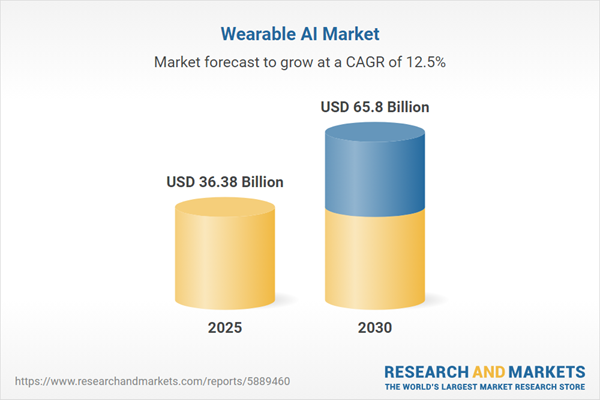Speak directly to the analyst to clarify any post sales queries you may have.
Enterprises seeking a robust digital transformation strategy are increasingly turning to wearable AI to gain operational agility and maintain an edge in competitive markets. As wearable AI solutions embed themselves in mainstream business, they are redefining workflows and providing data-driven decision support across industries.
Market Snapshot: Wearable AI Market Momentum and Opportunity
The wearable AI market is recording steady growth as businesses expand adoption in healthcare, industrial safety, and professional services. With advancements in device intelligence, secure networking, and integrated digital platforms, organizations are seeing automated workflows and rapid decision cycles. These innovations create new value by linking frontline staff to advanced analytics, supporting transparency, and streamlining processes. For senior leaders, partnership models and platform interoperability further reinforce business resilience and ensure that enterprises can unlock actionable insights from real-time data across diverse operational landscapes.
Scope & Segmentation of the Wearable AI Market
- Product Types: Includes fitness bands, smart watches, AR and VR smart glasses, wearable rings, smart patches, and specialized cameras, each supporting healthcare monitoring, workplace immersion, and activity tracking.
- Component Types: Utilizes advanced displays, AI-optimized processors, biometric and motion sensors, and analytics platforms for real-time integration within enterprise environments.
- Connectivity: Bluetooth, Wi-Fi, and cellular networks power seamless connections between wearable AI devices and enterprise infrastructure, enabling reliable collaboration and efficient information flows.
- Applications: Adopted for automotive safety, entertainment, sports, fitness, medical monitoring, and emergency response, facilitating improved productivity and responsiveness in daily operations.
- Distribution Channels: Enterprises access solutions via retail outlets, e-commerce, global online vendors, and proprietary models, allowing for procurement processes tailored to organizational strategy.
- Deployment Models: Both cloud-based AI processing and on-device intelligence are available, giving organizations the flexibility to balance scalability, security, compliance, and latency requirements.
- End Users: Serves healthcare professionals, senior care providers, defense and sports organizations, and individuals with targeted solutions meeting segment-specific priorities.
- Geographic Coverage: The Americas, EMEA, and Asia-Pacific lead adoption, with China, India, Japan, Australia, South Korea, and Indonesia as centers for innovation and evolving regulations.
- Featured Companies: Key providers include Apple Inc., Google LLC (Alphabet Inc.), Samsung Electronics, Microsoft Corporation, Vuzix Corporation, Polar Electro Oy, RealWear, Inc., and several regional suppliers focused on bespoke solutions.
Key Takeaways for Senior Decision-Makers
- Wearable AI delivers actionable analytics, empowering quicker resource allocation and timely operational adjustments for businesses adapting to dynamic environments.
- Embedded sensors and neural processors enable teams to respond efficiently and adapt workflows to meet emerging sector requirements with agility.
- Flexible deployment options help organizations align technology choices with compliance mandates and support unique business continuity plans.
- Hardware, software, and analytics integration streamline business processes and enhance adaptability to ongoing market and regulatory shifts.
- Commitment to stringent privacy and regulatory compliance builds stakeholder trust, ensuring enduring adoption of wearable AI across complex operations.
Tariff Impact: Addressing Supply Chain and Cost Pressures
Adjustments to US tariffs are compelling enterprises to review supply chain structures and enhance cost-efficiency in wearable AI adoption. Developing strong supplier relationships, advancing procurement automation, and diversifying sourcing strategies bolster resilience against fluctuating market conditions. These initiatives reinforce enterprise continuity and risk management as international trade environments evolve.
Methodology & Data Sources
Insights are grounded in secondary research, expert interviews, regulatory analyses, and targeted enterprise surveys. This comprehensive research strategy ensures that senior leaders receive validated, relevant intelligence to inform strategic planning and investment decisions.
Why This Wearable AI Market Report Matters
- Detailed market segmentation helps executives align transformation initiatives with emerging trends and growth opportunities.
- Practical recommendations guide efficient resource deployment, compliance management, and protection of key enterprise assets.
- Integrated benchmarking methods support enterprises in tracking digital transformation progress and defining clear, achievable improvement goals based on trusted market data.
Conclusion
Wearable AI now serves as a catalyst for enterprise optimization and strategic planning. Leadership focus, strong partnerships, and in-depth knowledge of evolving technology and regulation are central to deriving ongoing value from these investments.
Additional Product Information:
- Purchase of this report includes 1 year online access with quarterly updates.
- This report can be updated on request. Please contact our Customer Experience team using the Ask a Question widget on our website.
Table of Contents
3. Executive Summary
4. Market Overview
7. Cumulative Impact of Artificial Intelligence 2025
List of Figures
Companies Mentioned
The companies profiled in this Wearable AI market report include:- Apple Inc.
- BRAGI GmbH
- Empatica Inc.
- Garmin Ltd.
- Google LLC by Alphabet Inc.
- Motorola Solutions, Inc.
- LG Corporation
- Muse by Conzumex Industries Pvt Ltd.
- Meta Platforms, Inc.
- Omron Corporation
- OrCam Technologies
- Polar Electro Oy
- Samsung Electronics Co., Ltd.
- Solos Technology Limited
- Suunto Oy
- Vuzix Corporation.
- Xiaomi Corporation
- RealWear, Inc.
- Nexxbase Marketing Private Limited
- Amazfit by Zepp Health Corp.
- Brilliant Labs.
- Rokid Services
- ThirdEye Gen, Inc.
- Everysight Ltd.
- Titan Company Limited
- Microsoft Corporation
Table Information
| Report Attribute | Details |
|---|---|
| No. of Pages | 192 |
| Published | November 2025 |
| Forecast Period | 2025 - 2030 |
| Estimated Market Value ( USD | $ 36.38 Billion |
| Forecasted Market Value ( USD | $ 65.8 Billion |
| Compound Annual Growth Rate | 12.4% |
| Regions Covered | Global |
| No. of Companies Mentioned | 27 |









